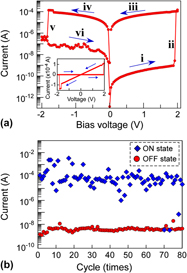Crossref Citations
This article has been cited by the following publications. This list is generated based on data provided by
Crossref.
Briggs, B.D.
Bishop, S.M.
Leedy, K.D.
and
Cady, N.C.
2014.
Characterization of hafnium oxide resistive memory layers deposited on copper by atomic layer deposition.
Thin Solid Films,
Vol. 562,
Issue. ,
p.
519.
Ito, Daisuke
Hamada, Yoshihumi
Otsuka, Shintaro
Shimizu, Tomohiro
and
Shingubara, Shoso
2015.
Temperature dependence of magnetoresistance characteristics of the on-state of resistive random access memory with ferromagnetic electrode.
p.
120.
Wang, M. J.
Gao, S.
Zeng, F.
Song, C.
and
Pan, F.
2016.
Unipolar resistive switching with forming-free and self-rectifying effects in Cu/HfO2/n-Si devices.
AIP Advances,
Vol. 6,
Issue. 2,
Bagdzevicius, S.
Maas, K.
Boudard, M.
and
Burriel, M.
2017.
Interface-type resistive switching in perovskite materials.
Journal of Electroceramics,
Vol. 39,
Issue. 1-4,
p.
157.
Khera, Ejaz Ahmad
Rasheed, Umbreen
Imran, Muhammad
Ullah, Hafeez
Hussain, Fayyaz
Khalil, R.M. Arif
Kousar, Farhana
and
Qasim, Muhammad
2022.
An insight into structural, electronic and optical characteristics of Mo1-xMxO3 (M = Zr, Y, ZrY) for the formation of conducting filaments in optoelectronic memory devices: A first principles study.
Optik,
Vol. 258,
Issue. ,
p.
168913.
Bagdzevicius, S.
Maas, K.
Boudard, M.
and
Burriel, M.
2022.
Resistive Switching: Oxide Materials, Mechanisms, Devices and Operations.
p.
235.
Dongale, Tukaram D.
Sutar, Santosh S.
Dange, Yogesh D.
Khot, Atul C.
Kundale, Somnath S.
Patil, Swapnil R.
Patil, Shubham V.
Patil, Aditya A.
Khot, Sagar S.
Patil, Pramod J.
Bae, Jinho
Kamat, Rajanish K.
and
Kim, Tae Geun
2022.
Machine learning-assisted design guidelines and performance prediction of CMOS-compatible metal oxide-based resistive switching memory devices.
Applied Materials Today,
Vol. 29,
Issue. ,
p.
101650.
Lupo, Federico Vittorio
Mosca, Mauro
Bagdzevicius, Sarunas
Rani, Rashmi
Maudez, William
Wagner, Estelle
Casaletto, Maria Pia
Basile, Salvatore
Benvenuti, Giacomo
Crupi, Isodiana
and
Macaluso, Roberto
2024.
HfO₂ Thin Films by Chemical Beam Vapor Deposition for Large Resistive Switching Memristors.
IEEE Journal of the Electron Devices Society,
Vol. 12,
Issue. ,
p.
508.
